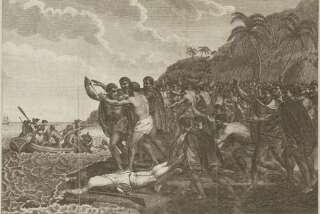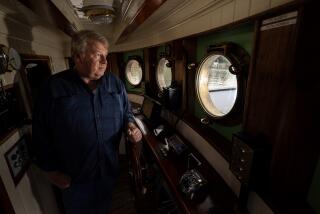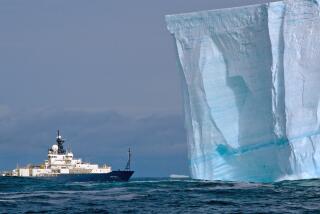An Adventure in the Arctic, Going West to East
AT SEA IN THE ARCTIC â Along the horizon, as far as the eye could see, shimmering cliffs of ice towered as if Dover had frozen over, or the Ancient Marinerâs tale where âthe ice was all betweenâ had come true.
It was a surrealistâs fantasy. The Beaufort Sea was calm, the sky was blue and the sunlight carried a crisp, clear edge of chill. Our small blue-and-white ship, World Discoverer, seemed trapped between icy cliffs on one side and the glittering, sand-colored skyscrapers of an Arctic Manhattan twinkling with lights and belching flames on the other.
Fire and ice in a vast, flat sea.
We were five days out of Nome, Alaska, attempting the first passenger-ship crossing of the Northwest Passage from west to east, and we were looking at something no map and no amount of reading had prepared us for, one of the Arcticâs more devious tricks, a mirage effect called âlooming.â
Explorerâs Bane
The stark icy cliffs to our port side were illusions, the flat icecap of the Beaufort Sea reflecting against itself in the morning sunlight. (How many explorers desperately searching for the Northwest Passage during the last 400 years had seen a similar wall of ice ahead and turned back?)
To the starboard side, an indefinable distance away in the clear air and flat Arctic landscape, the âcityâ was Prudhoe Bay, its oil platforms and administration buildings reflecting upside down and right side up in several layers, suspended in a gray aspic between sea and sky.
The ice pack was much heavier than expected. Since dawn, when we had witnessed another rare phenomenon, a âgreen flashâ at sunrise on the sea, we had watched the ship weave its way through the thickening ice. At 9 a.m. Capt. Heinz Aye and ice master Capt. William Stuart made the decision to reverse our course. At least for a moment, we turned back.
Last Adventure
Sailing through the Northwest Passage may well be the last adventure in reach for the well-heeled passenger whoâs been everywhere. The landscape of the frozen Arctic is still as barren and hostile as it was when it reduced doughty explorers and expeditioners to starvation, murder and cannibalism, and wiped whole ships off the earth.
For everyone whose idea of a cruise is a warm, lazy sail through the islands of the Caribbean or South Pacific, a 32-day voyage from Nome to Halifax across the Arctic archipelago, the worldâs largest island group, would have about as much appeal as a hiking tour of purgatory or a weekend in a walk-in freezer.
But one look at this motley crew of adventurers dispelled any doubts. We numbered 80, with a median age of 69 standing on deck bundled up in Society Expeditions parkas, scanning the horizon with binoculars, photographing ice floes, almost giddy with the excitement of being here.
No Guarantee
For the moment, at least, it seemed to be worth the $14,900 to $26,300 apiece they had paid to attempt the Northwest Passage, with no guarantee of getting through and no definite itinerary along the way.
A surprising number of men and women were aboard alone, leaving reluctant spouses behind in warmer places. For many, there was the tug of the unknown, the âbecause-itâs-thereâ spirit.
âFrom the time I was 12 years old I read everything about the polar expeditions I could get my hands on,â an Arizona woman said. âThe idea of going west to east really excited me.â
A Los Angeles man was celebrating his 50th birthday by sailing as close as possible to both poles; he completed an Antarctic cruise earlier this year.
A vivacious redhead from Rio de Janeiro had asked her travel agent to find âsomewhere with ice and snow.â A couple from Switzerland had sailed the Antarctic and now were attempting the Arctic.
Purpose-Built Ship
After more than five hours of negotiating the ice-laden Beaufort Sea in a zigzag route that took us through waters so shallow there were sometimes only three or four feet of clearance beneath us, we began to appreciate the World Discovererâs ice-hardened hull and shallow draft.
The mystique of the Northwest Passage may come in part from the legendary explorers who were here before us: Martin Frobisher in the 16th Century; Vitus Bering, a Danish captain in the 18th-Century Russian navy; Sir John Franklin, lost at the age of 59 on his third search for the passage in the 1840s; the Norwegian Roald Amundsen, who spent three years in his combined effort to study the North Magnetic Pole and to find the Northwest Passage.
More than once aboard the World Discoverer we were to feel pangs of guilt, hearing about explorers who had to boil and eat their boots while the growing problem among ourselves was weight gain from the lavish, beautifully prepared meals of our Viennese chef, Hans Baumhauer.
Aurora Borealis
On many nights we were awakened to see the aurora borealis and stand shivering on the forecastle away from the deck lights while the sulfurish yellow and green patterns streaked and swirled in the sky.
Our weather varied tremendously, from a balmy, sunny, 68-degree morning at Herschel Island, an abandoned whaling station at the northernmost tip of Canadaâs Yukon Territory, to fresh snow and driving sleet blown by an icy wind at Cambridge Bay on the east end of Victoria Island.
The day after Cambridge Bay, as we sailed the gulfs and straits between the mainland of the North American continent and the islands of the Canadian Arctic, we encountered winds of 45 knots and the captain ordered the cabin portholes covered on all the lower decks.
Through the night we picked our way through the ice of Queen Maud Gulf, and by midday, in Requisite Channel, we pitched and rolled in a very rough sea.
Icebreaker Assists
The Canadian Coast Guard icebreaker Camsell informed us that the storm we were experiencing had destroyed many of the buoys in narrow, shallow Simpson Strait, which lies between the mainland and King William Island, and offered to lead us through. Afterward we anchored near each other, and the officers and crew of the Camsell came on board the World Discoverer for a lively evening in the main salon bar.
The next morning we called at the hamlet of Gjoa Haven on King William Island, named for Roald Amundsenâs ship Gjoa, which spent two winters there. Relics, graves and skeletons of the ill-fated Franklin Expedition have also been found on the island.
Gjoa Haven, although tidier than some, is typical of the Inuit villages we have visited: fairly new wooden houses, half a dozen broken snowmobiles, barking dogs, polar bear, seal or musk ox skins drying on clotheslines, fishing boats on the beach with outboard motors, etc.
It offers, among other packages, a traditional spring Inuit experience aboard a two-day dog-sled trip across the ice from Gjoa Haven to Spence Bay on Boothia Peninsula.
Thar She Blows
From Gjoa Haven we turned north, bound eventually for the northernmost point on our voyage, Little Cornwallis Island at 75 degrees 23 minutes north. En route we saw a polar bear with two cubs just inside the mouth of narrow Bellot Strait, the often mist-shrouded entrance to Prince Regent Inlet. We played tag with a rare bowhead whale that teased us with arches and arcs, tumbles and rolls and spouts, its elephant-gray skin gleaming in the water.
Sailorsâ Graves
At Beechey Island, where the Franklin Expedition spent its first winter, we saw the graves of three sailors who died and were buried there. As we walked across the island from the gravesites to the cache and âpost officeâ used by early explorers, we felt like moon walkers crossing a lifeless planet, with nothing except rocks and lichen and rusted 19th-Century tin cans discarded by expeditioners.
After Beechey Island we encountered the first huge icebergs from Greenlandâs glaciers, and after several calls at villages on Baffin Island crossed into Baffin Bay and the Atlantic Ocean.
Making It Official
On Tuesday evening, Sept. 9, precisely at 8 p.m., we officially completed the first passenger ship west-to-east crossing of the Northwest Passage, the 36th ship of any kind to make the passage.
There would be two more weeks of cruising and visits to unexplored fiords of Baffin Islandâs east coast, Greenlandâs west coast, Labrador, Newfoundland and Nova Scotia, but we had already accomplished what weâd set out to do, travel a mysterious and notorious sea route in places no passenger ship had ever been, and, in the doing, perhaps learn more about ourselves.
For other cruise dates and prices, contact your travel agent or Society Expeditions toll-free at (800) 426-7794 or (206) 324-9400.
More to Read
Sign up for The Wild
Weâll help you find the best places to hike, bike and run, as well as the perfect silent spots for meditation and yoga.
You may occasionally receive promotional content from the Los Angeles Times.






